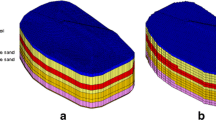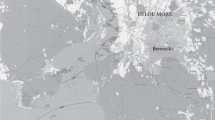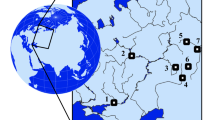Abstract
The study zone is located in the city of Padova (the Veneto region, NE Italy). The industrial activities present in this area since 1950 have produced very high concentrations of Pb, Zn, Cu, Pcb and oils until a depth of 7 m. The unsaturated and the saturated zones are both polluted. Because of the abundance of Pb values it was decided to analyze the lead distribution in the studied zone. In many studies of the polluted sites, the geometry of the investigated volume is highly anisotropic. Generally we have an extension of some hectares in the horizontal plane and of a few meters in depth. It is likely that different horizontal spatial continuity structures in pollution distribution are found at different depths both for the layered nature of the medium and for the transition between unsaturated and saturated conditions. In such conditions the decision to divide a 3D problem into 1D and 2D problems can be useful. Initially the studied volume was divided into seven layers up to 5 m in depth; the study was then approached in two phases. First, the Pb values in the vertical direction were analyzed, considering a derive along z, and estimating the values using the Kriging with Trend (KT) method. Thus it was possible to increase the data in the z direction, especially in the deeper layers. Second, 500 realizations of the Pb distribution for each of the seven layers were simulated using the simulated annealing procedure. Finally, results were presented and discussed for each layer in terms of median and probability maps.
Similar content being viewed by others
References
Carle, S. F., 1997, Implementation scheme for avoid artifact discontinuities in simulated annealing: Math. Geology, v. 29, no. 2, p. 231–244.
Chilès, J. P., and Delfiner, P., 1999, Geostatistics: Modelling Spatial Uncertainty: Wiley, New York, 695 p.
Desbarats, A. J., 1996, Geostatistical estimation: Kriging, in Rouhani, S., Srivastava, R. M., Desbarats, A. J., Cramer, M. V., and Johnson, A. I., eds., Geostatistics for Environmental and Geotechnical applications: American Society for Testing and Materials, West Conshohocken, Pennsylvania, p. 32–50.
Deutsch, C. V., 1989, DECLUS: a Fortran 77 program for determining optimum spatial declustering weights: Computers & Geosciences, v. 15, no. 3, p. 325–332.
Deutsch, C. V., and Journel, A. G., 1998, GSLIB Geostatistical software library and user's guide: Oxford University Press, New York, 369 p.
Deutsch, C. V., and Journel, A. G., 1994, Integrating well test-derived effective absolute permeabilities in geostatistical reservoir modeling, in Yarus, J. M., and Chambers, R. L., eds., Stochastic modeling and geostatistic: principles, methods, and case studies: Amer. Assoc. Petroleum Geol., Tulsa, Oklahoma, p. 131–142.
Deutsch, C. V., 2002, Geostatistical reservoir modeling: Oxford University Press, New York, 376 p.
Fetter, C. W., 1999, Contaminant hydrogeology: Prentice Hall, Upper Saddle River, New Jersey, 500 p.
Goovaerts, P., 1997, Geostatistics for natural resource evaluation: Oxford University Press, New York, 483 p.
Goovaerts, P., 2001, Geostatistical modeling of uncertainty in soil science: Geoderma, v. 103, no. 1, p. 3–26.
Isaaks, E. H., and Srivastava, M. R., 1989, An introduction to applied geostatistics: Oxford University Press, New York, 561 p.
Journel, A. G., and Huijbregts, C. J., 1978, Mining geostatistics: Academic Press, New York, 600 p.
Pannatier, Y., 1996, Variowin: software for spatial data analysis in 2D: Springer, New York, 91 p.
Ploner, A., 1999, The use of variogram cloud in geostatistical modeling: Envirometrics, v. 10, no. 4, p. 413–437.
Rouhani, S., 1996, Modeling spatial variability using geostatistical simulation, in Rouhani, S., Srivastava, R. M., Desbarats, A. J., Cramer, M. V., and Johnson, A. I., eds., Geostatistics for Environmental and Geotechnical applications: American Society for Testing and Materials, West Conshohocken, Pennsylvania, p. 20–31.
Van Laarhoven, P. J. M., and Aarts, E. H. L., 1987, Simulate annealing: theory and application: D. Reidel, Dordrecht, The Netherlands, 186 p.
Author information
Authors and Affiliations
Corresponding author
Rights and permissions
About this article
Cite this article
Fabbri, P., Trevisani, S. A Geostatistical Simulation Approach to a Pollution Case in Northeastern Italy. Math Geol 37, 569–586 (2005). https://doi.org/10.1007/s11004-005-7307-6
Received:
Accepted:
Issue Date:
DOI: https://doi.org/10.1007/s11004-005-7307-6




